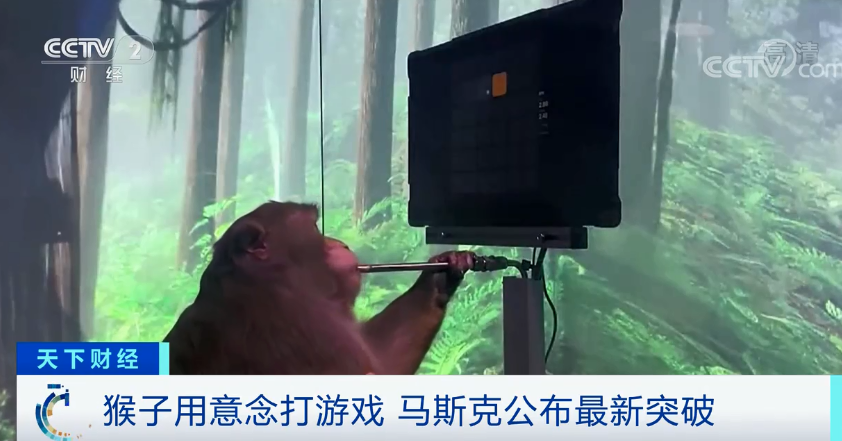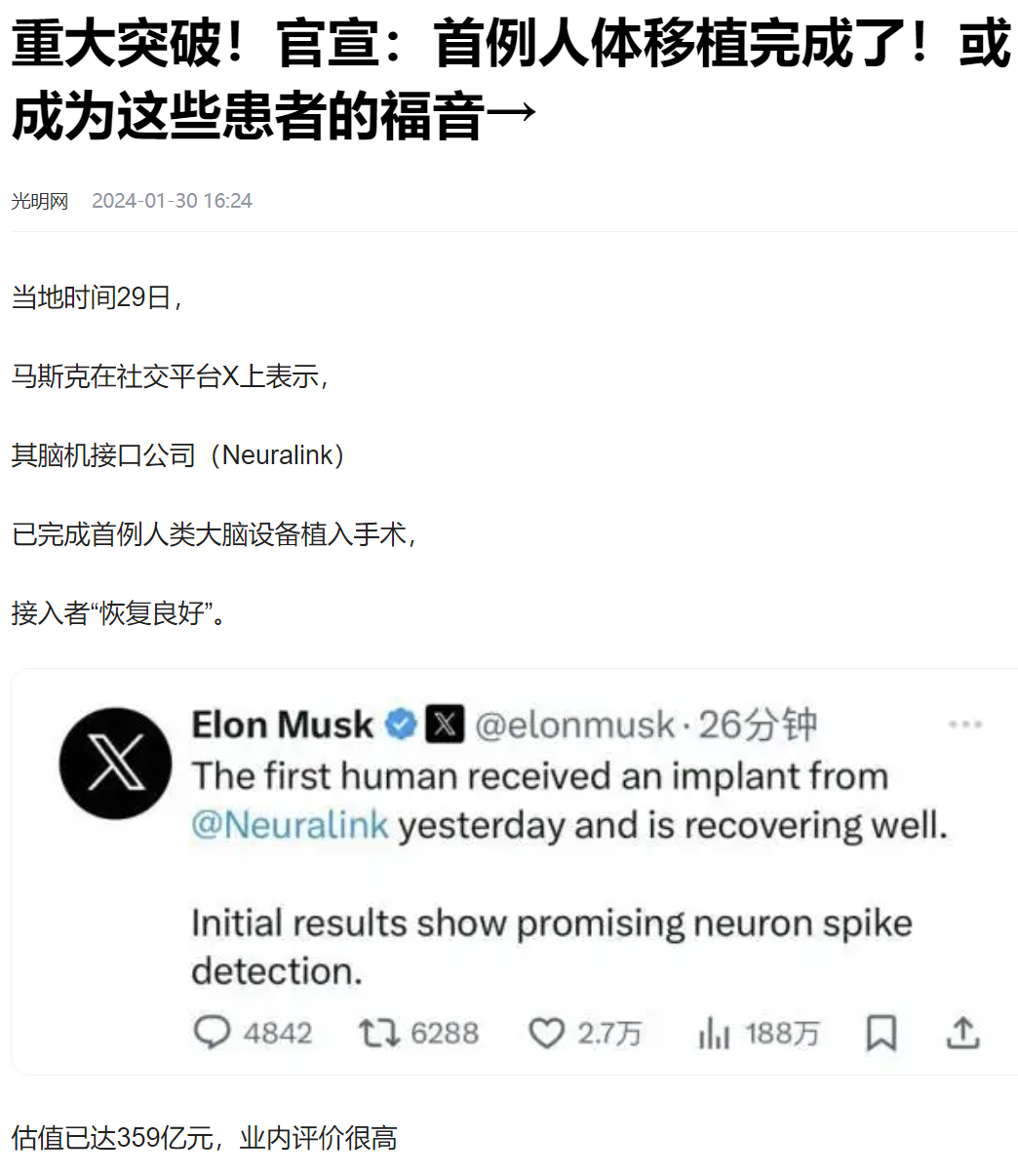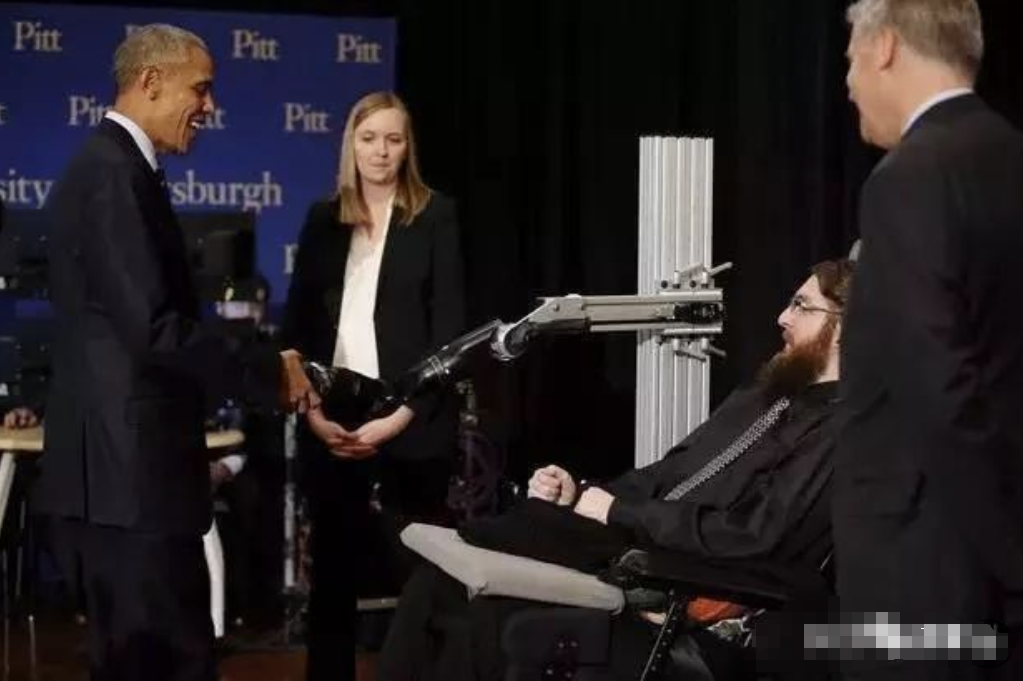In 2016, Musk founded a brain-computer interface company called Neuralink, which claims to be building a device that will allow the human brain to interact with the outside world, the future of mankind will be able to achieve what netizens call cyber ascension. Although Musk, who has secured electric cars and recyclable rockets, and invested in AI, already has a halo of myth, putting a device directly into the human brain, is it possible to use the device to instantly convert brain signals into electrical signals to manipulate objects? There are plenty of sceptics, but Elon Musk shrugs them off. In August 2020, Musk announced that he had successfully implanted a device in the pig brain that can read neuronal activity in real time and wirelessly transmit data, verifying the compatibility and long-term stability of the brain-computer device and the organism. In 2021, Musk released a video showing a monkey playing the computer game Pong through a brain-computer interface, controlling cursor movements with thoughts alone. This experiment proves that non-human primates can complete complex tasks through brain-computer interface.

In May, Musk’s Neuralink 2023 FDA approval to begin human clinical trials. In January, Musk announced that he had 2024 the first human patient, a quadriplegic named Nolan Arbor, with a device called”Telepathy,” and that he was recovering well, electronic devices such as computer cursors and cell phones can be controlled by thought alone.

In August, Musk announced the 2024 of a second brain-computer interface, allowing subjects to play video games and learn 3-d design software. Is Musk’s brain-computer interface really that good? Is it really possible for humans to control objects with their minds? Yes, it can, and several tests have shown that it can, without endangering the lives of the subjects. But Elon Musk’s brain-computer interface technology has a lot of limitations at this stage.
For example, brain-computer devices implanted in the human body after 6 months, found that the signal attenuation of 40% of the phenomenon, in terms of functionality equivalent to playing games you will card into powerpoint. Nanoelectrodes are being developed to solve this problem, but they are still in the laboratory stage. Energy supply, for example, is a big problem. Wireless power lasts less than 72 hours. There is a breakthrough in using cerebrospinal fluid (CSF) glucose to generate electricity, but it can provide a fraction of the power needed. For example, the human body’s self-healing ability will form callus tissue near the invasive brain-computer interface, form glial scars, and create a physical barrier to isolate the”Foreign body” of the brain-computer interface, as a result, the signal resolution of brain-computer interface (BCI) is reduced, and the electrode shift may occur, which may require reoperation for calibration. And chronic inflammation at the implant site can trigger neuronal degeneration, which experts estimate can render 30 percent of invasive devices useless within five years. For example, the cost of a brain-computer interface can be as high as $70,000 to $250,000. Musk’s invasive brain-computer interface devices are the best, but also the most difficult. The surgery alone costs $250,000, far beyond the capacity of most human beings. All of which proves that Elon Musk’s brain-computer interface technology, at this stage, isn’t very useful for very few people and very few scenarios. Although Musk’s Neuralink mainly makes invasive brain-computer devices, humans have also invented non-invasive brain-computer devices that are much safer, but because of the skull’s ability to shield signals, at present, the signal accuracy of non-invasive brain-computer equipment is low, the delay is huge, and it can only detect part of the signal of the cerebral cortex, and has no ability to detect signals deep in the brain, so it is also very useless. However, the brain-computer interface seems to belong to the high technology of the future world. Once human beings have broken through the constraints of implanted devices, for example, using nanotechnology or biotechnology to form a device, that brain-computer interface could not only help paralyzed people get back on their feet, it could even allow ordinary humans to send high-frequency incoming and outgoing messages. It will be possible in the future to surf the internet, work or even learn out of thin air, and to reverse-feed vast amounts of knowledge into the brain via brain-computer interfaces in a short period of time.

The human mind is now so knowledge-intensive that 30 years of study by a normal human being would only capture a fraction of a fraction of a fraction of a fraction of a fraction of a fraction, a few centuries ago, the world’s great scientists were proficient in mathematics, physics, and chemistry. By the 19th century, few people in the world were proficient in both mathematics and physics. For example, most of today’s human physics experts, in fact, only proficient in a branch of physics or even a branch of the subject, fully proficient in the entire content of physics, it has been a long time ago. It takes 30 years to learn a branch, but humans can’t work until they’re 70 at most. The limits of human technology are set by the efficiency of brain learning and human lifespan, if this can’t be solved, the future of humanity will be locked away. Either let human beings achieve long life, or let human beings can learn a lot of knowledge in a very short time. Countries that break through these technologies will, in a very short period of time, raise their scientific capabilities to another dimension, and the gap between their capabilities and those of the average human will be so large that it will be hard to overstate the difference between two species. And brain-computer interface technology, it is possible to achieve this goal. So every time Musk announces a new development in brain-computer interfaces, it will cause a heated discussion around the world, because no matter how trivial it is, it also represents the future of mankind, every technological breakthrough represents a step toward the future, and when it doesn’t, no one else will be able to catch up. Musk’s ability to produce so many BCI results in such a short period of time is, of course, related to his ability, but more importantly, the entire U. S. Scientific and technological background. Elon Musk wasn’t the first to develop a brain-computer interface.
In 1969, U.S. researcher Eberhard Fitz, in a biology experiment, linked a neuron in a monkey’s brain to a dashboard and found that the needle on the dashboard would rotate. Fes then rewarded the monkey with a banana every time he noticed the dial needle turning, and the monkeys got better at firing the neuron in a certain way to eat more bananas. The experiment was just”Fun,” but it opened the door to brain-computer interface technology and caused a global sensation at the time. In 1970, the Defense Advanced Research Projects Agency (DARPA) began setting up teams to work on brain-computer interfaces. In 1978, William Dobelle, a pioneer of visual brain-computer interfaces, implanted an array of 68 electrodes into the visual cortex of a blind man, Jerry, and successfully created the illusion of light, this allows the blind person to see a low-resolution, low-refresh-rate bitmap image in a limited field of view. In 1998, Philip Kennedy and Roy Bakay of Emory University, brain-computer specialists at motor prosthesis, implanted devices in the brains of Johnny Ray, a patient with locked-in syndrome caused by a stroke in the brain stem, the success helped Ray control a computer cursor using the brain-computer interface. In 2005, Cyberkinetics, an American company, won FDA approval to conduct a Phase I clinical trial of a motor cortex brain-computer interface in nine patients, successful let quadriplegic patients through the motion intention to complete robotic arm control, computer cursor control and other tasks. At the 2012 World Cup in Brazil, amputees in robotic armor scored a goal with a brain-computer interface and a robotic exoskeleton.
In September 2016, researchers at Stanford University implanted devices in the brains of two monkeys and trained one of them to type 12 words a minute. Paralyzed man Nathan Copeland”Shakes Hands” with US President Obama using a mind-controlled robotic arm in the first regained consciousness in a fully paralyzed patient on October 13,2016.

So when Elon Musk started Neuralink, a brain-computer interface company, in 2016, it was a natural thing to do. It wasn’t crazy. It wasn’t that hard, with all the brain-computer talent that had been nurtured across the United States over the years, this is not to say that human brain-computer interfaces should be built from scratch, just that Musk’s ability to commercialize them would accelerate the evolution of human brain-computer interfaces.
But that seems even scarier. If BCI technology represents the future, and if the U.S. has more BCI talent and teams than musk, what will china do? Don’t worry, because all the technologies developed in the United States, no matter what they are, no matter whether they seem to be useless or not, China is all R & D, and has invested long-term funds in R & D, the most is poor time less investment, rich time more investment, but always invest money. The Chinese have been working on brain-computer interfaces for years, and the results have been impressive.
They’ve done it, they’ve said it, but not as well as Elon Musk, and not as many people know about it. When Elon Musk made the BCI, we did report it, but in fact, when we made the BCI in China, we also reported it. In 2006, Gao Shangkai’s team at Tsinghua University in China performed the country’s first invasive brain-computer interface animal experiment, successfully allowing monkeys to control the movements of robotic arms through EEG signals. In 2014, the Mingdong team at Tianjin University broke through non-invasive BCI technology and developed the Shengong-1 rehabilitation system to help stroke patients use EEG signals to drive the exoskeleton for limb rehabilitation training, in the same year, it became the world’s first approved brain-controlled exoskeleton rehabilitation device.
In 2016, Zhejiang University team Zheng Xiaoxiang used the latest flexible electrodes and real-time decoding algorithms to allow monkeys to complete snatches using a robotic arm through an invasive brain-computer interface, the move represents China’s achievement of intrusive closed-loop control of BCI. In 2019, a Chinese Capital University of Medical Sciences Capital Medical University Affiliated Beijing Tiantan Hospital Zhejiang University implanted a Utah array of electrodes in a patient with a spinal cord injury, allowing the patient to drink and eat with a robotic arm controlled by thought, this is the first time in China to realize the functional reconstruction of the invasive brain-computer interface in the human body. In 2020, South China University of Technology Li Yuanqing’s team launched a”Brain-computer intelligent wheelchair” that allows users to control the wheelchair’s thoughts using scalp electroencephalography (EEG) with an error rate of less than 5% , the first consumer-level application of non-intrusive BCI in China is implemented. In 2022, Tao Hu’s team at the Shanghai Institute of Microsystems of the Chinese Academy of sciences developed a”Silk protein flexible electrode” that can degrade naturally and has extremely low rejection, long-term stable reading and stimulation of mouse brain signals (two-way communication) is achieved.
The 2023, Tianjin University and Nankai University have launched the”Brain Whisperer” system, which breaks the world record for the fastest non-intrusive BCI system with a decoding speed of 690 characters per minute, enabling ALS patients to communicate with the outside world. In 2023, Huawei issued a patent for a”Brain-computer interaction headset”. The 2024, Enterprise Brain Tiger Technology, has completed the first clinical implantation of a flexible brain-computer interface (BCI) . The patient can control a smart home with his thoughts, using bionic flexible electrodes, and the implant trauma is less than 1 mm. In March 2025, Capital University of Medical Sciences Zhao Guoguang’s team successfully implanted beinao-1 into the brain of an ALS patient. Three hours after surgery, the accuracy rate of language decoding reached 34% , eventually rising to 52% , can express”I want to drink water”, “Want to go for a walk” and other complex statements.
These are just some of the advances in China’s brain-computer interface (BCI) technology that have already been reported by state media. In 2016, NUDT also broke new ground with brain-computer interface technology, using non-invasive brain-computer devices to allow Shenzhou 11 astronauts to conduct brain-computer interaction experiments. Also in 2016, the Chinese Air Force launched a brain-computer interface experiment to try to use the interface to control military equipment. In 2019, the China Academy of Aerospace Science and Technology successfully let subjects control a drone through a brain-computer interface. In addition to these, we have also reported on every technological breakthrough in civilian brain-computer interfaces. Photos and videos of paralyzed patients in China using brain-computer interfaces to control robotic arms, play mahjong, and so on, are readily available. It’s true that few people know about China’s years of BCI research and development, but we’ve been doing it and reporting on it. Today, China’s brain-computer interface technology has reached the point where it can be used commercially. It is not yet widely available, but it is being sold because it is needed by many patients with mobility problems.
Hubei Medical Insurance Bureau issued a notice on March 31 st ST stipulating the price of medical services for the BCI project, the first of its kind in China. Instead of $70,000 or $250,000, the procedure costs 966 to 6,552 renminbi, or $138 to $936. Hubei province, the brain-computer interface surgery cost quote what is the point? First of all, this price standard is very close to the people, and the United States 7-25 million U. S. dollars compared to only a fraction. But this is not just to quote a very low price, but it represents that hospitals in Hubei province have the technical strength to do this surgery.
Only when you can do the surgery can the price be meaningful, and if you do brain-computer interface surgery in Hubei province, the hospital will only charge according to the standard published by Hubei Medical Insurance Bureau. Invasive brain-computer interfaces (BCI) are typically tried only by people with general paralysis or ALS, but non-invasive bcis are widely available and are now being commercialized, it costs $70,000 in the U. S. and only 966 yuan in China. The pricing of medical services for BCI in Hubei province represents a key step in the transformation of BCI technology from scientific research to clinical practice in China.
In the short term (1-3 years) , brain-computer interface technology can treat conditions such as paralysis, aphasia and Parkinson. In the medium term (5 to 10 years) , BCI technology can be extended to depression treatment, educational training (such as attention monitoring) , industrial safety, etc. . In the long run, brain-computer interface (BCI) technology can help human beings to realize the integration of human-computer intelligence and enhance memory or learning ability. Elon Musk’s company is well known for its brain-computer interfaces, but his is not the only one working on them. In some countries, not only have they been working on them for years, but a large number of teams have been working on them from different angles, it’s just that few people know about it. If the future of brain-computer interfaces is truly about technological advancement, China will be the first to achieve it, and the U.S. won’t even have the lead it had for a few short years in new-energy vehicles and AI. Non-invasive brain-computer interfaces cost $138 in China and $70,000 in the U.S. . The advantage is unlikely to be in the U.S. .
Image from the web